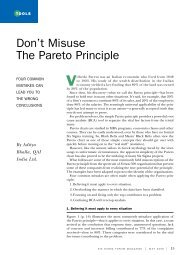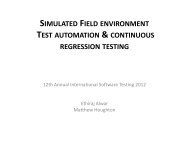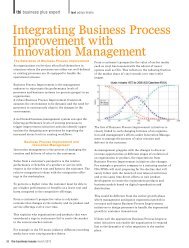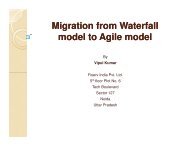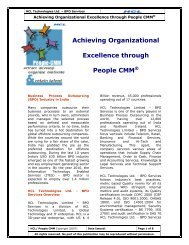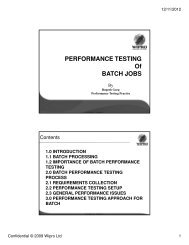Deployment of Earned Value Management Systems in Project ... - QAI
Deployment of Earned Value Management Systems in Project ... - QAI
Deployment of Earned Value Management Systems in Project ... - QAI
Create successful ePaper yourself
Turn your PDF publications into a flip-book with our unique Google optimized e-Paper software.
The basic component <strong>of</strong> EVM is the WBS – represent<strong>in</strong>g the deliverables to be produced at the<br />
lowest level as Work packages. The l<strong>in</strong>e <strong>of</strong> decomposition <strong>of</strong> Work packages facilitates Activity<br />
def<strong>in</strong>ition, responsibility assignments and management <strong>of</strong> risks at the micro level. Activities get<br />
associated at the Work Package level.<br />
EV can be tracked at the Activity level or the Deliverable level. The activities controlled by<br />
s<strong>in</strong>gle manager get grouped together as Control Account Plan (CAP), which usually co<strong>in</strong>cides<br />
with the EVM report<strong>in</strong>g levels. Thus, <strong>in</strong> effect, CAPs are derived by tak<strong>in</strong>g WBS and<br />
Organisational Breakdown Structures (OBS) together <strong>in</strong>to account.<br />
Cost Basel<strong>in</strong>es are derived from planned resource allocations and resource rates across the<br />
<strong>Project</strong> lifecycle. This Basel<strong>in</strong>e represents Budgeted Cost <strong>of</strong> Work Scheduled (BCWS), which is<br />
also called the Planned <strong>Value</strong> (PV) for the project. (Note – BCWS etc were nomenclature used<br />
<strong>in</strong> earlier versions <strong>of</strong> application <strong>of</strong> the method and are reta<strong>in</strong>ed for understand<strong>in</strong>g purposes<br />
only)<br />
Most <strong>of</strong> the <strong>Project</strong>s use automated <strong>Project</strong> <strong>Management</strong> Information <strong>Systems</strong> (PMIS) to<br />
load cost data dur<strong>in</strong>g the <strong>Project</strong> execution. Typically, the actuals vary from budgets<br />
due to multiple factors – <strong>in</strong>clud<strong>in</strong>g resource usages, resource rates and difference <strong>in</strong> the tasks<br />
performed as compared to schedule. The cumulative costs <strong>in</strong>curred dur<strong>in</strong>g the <strong>Project</strong> life<br />
cycle get plotted as the Actual Cost <strong>of</strong> Work Performed (ACWP), also called Actual Costs (AC)<br />
currently.<br />
The next element <strong>in</strong> the EV <strong>Management</strong> system is to determ<strong>in</strong>e the Budgeted Costs <strong>of</strong> Work<br />
performed. ( BCWP) – which is also commonly known as the <strong>Earned</strong> <strong>Value</strong> (EV). Here<strong>in</strong>, we<br />
assess the extent <strong>of</strong>work performed at any time and relate it to the orig<strong>in</strong>al budgets. BCWP can<br />
be determ<strong>in</strong>ed <strong>in</strong> different ways:<br />
- Based on Task percent completion, prorate the budgeted costs<br />
- Load<strong>in</strong>g EV accruals for <strong>in</strong>termediate Phases<br />
EV Calculation for assessment <strong>of</strong> current performance<br />
At any <strong>in</strong>termediate po<strong>in</strong>t dur<strong>in</strong>g the <strong>Project</strong>, we have three factors:<br />
a) Actual Costs (AC) : Actual Costs <strong>of</strong> the Work Performed so far, which get typically<br />
accumulated via the <strong>Project</strong> Account<strong>in</strong>g system established for the <strong>Project</strong>.<br />
b) Planned <strong>Value</strong> (PV) which is the Budgeted Cost <strong>of</strong> Work Scheduled so far.<br />
c) <strong>Earned</strong> <strong>Value</strong> (EV), which is the Budgeted Cost <strong>of</strong> Work Performed so far.<br />
Above three factors are basic to EV calculations.<br />
The variance <strong>of</strong> actual performance with planned schedule arises on account <strong>of</strong> slippages <strong>of</strong><br />
two k<strong>in</strong>ds:<br />
A) Schedule slippage: Tasks are not gett<strong>in</strong>g completed as per planned schedule. This is<br />
measured by Schedule Variance (SV), as EV – PV or Schedule Performance Index (SPI), which is<br />
computed as EV/PV.<br />
At the reference time po<strong>in</strong>t, this formula computes the ratio <strong>of</strong> the value <strong>of</strong> the Work<br />
performed to the value <strong>of</strong> the Work Scheduled. As expected, any value <strong>of</strong> SPI greater than 1 is<br />
favorable for the <strong>Project</strong> <strong>Management</strong>.<br />
- 2 -



